Odds & Ends Kaldheim, Part 1
Every set, I like to have a mailbag column or two where I answer your questions about the set. Today, it's time to answer your questions about Kaldheim. Here's the tweet I posted:
It's time for me to write a mailbag column about #MTGKaldheim. Please keep your questions about Kaldheim to a single tweet, one question per tweet. Thanks. #WotCStaff
— Mark Rosewater (@maro254) January 22, 2021
As always, I'll try to answer as many questions as I can, but here's why I might not answer your question:
- I have an allotted word count, which means that there are only so many questions I can get to.
- Someone else might have asked the same question. I will usually answer the first person who asks.
- Some questions I either don't know the answer to or don't feel qualified enough in the area to answer properly.
- Some topics I'm not allowed to answer for all sorts of reasons, including previews for future sets.
That said, on with the questions:
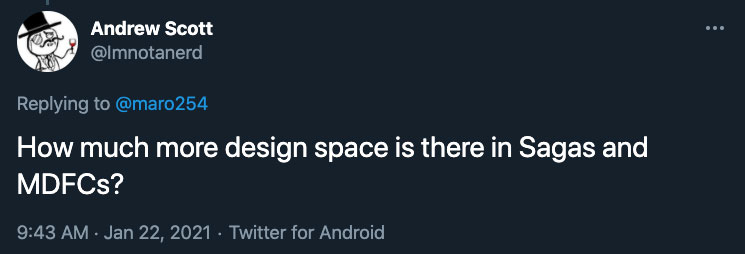
Before I answer this question, I need to clarify some terminology. When talking about design potential for a mechanic or tool, there is what I would call available space and practical space. Available space is the totality of what could possibly be designed. Practical space is what I believe would be realistically usable in a future set. Being "realistically usable" hits upon many facets. Does the totality of the design feel cohesive? Would it play well? Does it fit on a card? Is it something that we can properly convey through text? Does it work within various design constraints like color pie and rarity?
For example, Sagas have a much bigger available space than a practical space. Making a Saga that feels right and plays right is a lot trickier than it might seem. That said, the practical space is large enough that I believe we can make use of it for years to come if we're careful with how much we make and where we use them. The constraint on Sagas that concerns me most is that they work best when conveying a story, which puts a lot of pressure on the world to carry that weight. I believe worlds that tap into trope space where we're telling stories or story archetypes that the audience already knows or revisiting planes where the world has stories we've created for it in the past work best.
Modal double-faced cards (MDFCs) have a narrower gap between the available and practical space. The bigger problem MDFCs have is that it's much easier to have one MDFC feel like another one. This can be solved by spreading them out over time so there's less comparison. They also fight with other mechanics that play in a similar space (like Adventurer cards). With all those caveats, I believe MDFCs have a larger practical design space than Sagas. And DFCs (double-faced cards, of which MDFCs and TDFCs are subsets), as a whole, have a huge available design space.

I guess that would be foretell, as an element of it came from layaway, a mechanic that was inspired by the Star Wars Trading Card Game (which came out in 2002). The mechanic created the longest ago that shows up in the set would be the snow "mechanic," which first appeared in Ice Age in 1995. I should note that while snow-covered basic lands and cards caring about them were in Ice Age, the snow supertype and snow mana didn't show up until Coldsnap in 2006.
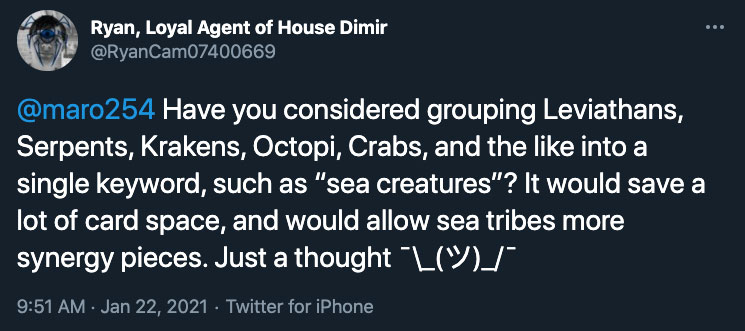
One of Magic's many tensions is the number of creature types we support. Support too many, and there aren't enough cards to make up a tribal deck. Support too few, and the game lacks flavor. For example, in Weatherlight, we tried an experiment where we labeled every undead thing (save Zombies, for some reason) as creature type Undead. Players didn't like it. They preferred having the undead types spelled out.
The stance that I've been advocating concerns us being more proactive about grouping creature types together flavorfully. We could do it with batching, meaning we list a word that we then define as this collection, but that comes with some issues. First, we can only list so many creature types, and using terminology like "sea creatures" gets weird when we can't list all the creature types that are sea creatures. ("How come the card doesn't affect my Sharks? They're sea creatures.") This can also happen because we're always adding new creature types. Maybe at the time we made a batch, it covered everything, but it becomes awkward when we make a new creature type that fits. Second, we tend to have thresholds before we invoke new vocabulary. Part of that is a comprehension issue, which I do recognize is a pretty low barrier in this case, as the words we're using are merely helping to explain the grouping, but another part is not wanting to use up a word for a card or two that we might want to use later.
I am on your side here. I do think there's a big future in creating deck design constraints that mix and match existing game components (and not just creature types), so I'll say I'm optimistic that this type of thing will happen more often.
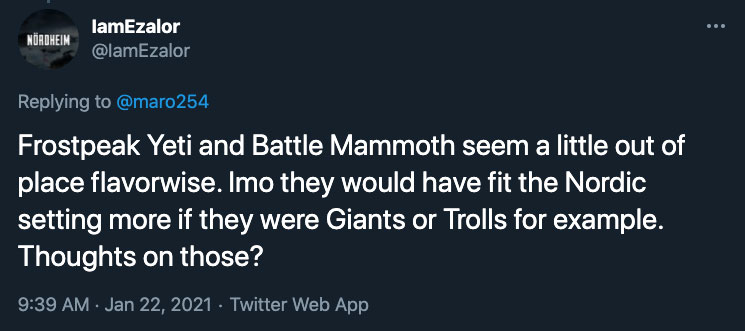
One of the challenges of creating a Magic world inspired by a real-world source is finding ways to add our own touch to it. One of the things we'll do is take fantasy creatures that aren't from the source material but feel very much at home in it. For example, leonin are not part of Greek mythology, but their aesthetic felt right for Theros. There's a similar thing going on here. We're making a world with a heavy snow influence. A Yeti or a mammoth (creature type Elephant) feel very at home in that setting. Another reason is a flavor monotony issue. Tribal themes push us to want a lot of the same creature types, but if we collapse the available pool too much, it gets a bit repetitious.

I did not. My main responsibility was making sure a legendary Squirrel ended up in the set, but I got no resistance, so it wasn't the most daunting of tasks.
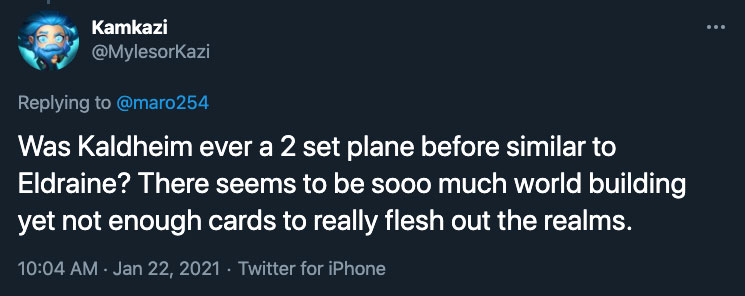
The short answer is no.
The longer answer is that the idea for a Norse set popped up a lot over the last twenty or so years. During most of that time, the default was either three-set or two-set blocks, so we did have discussions about how we might do a Norse world broken up over multiple sets. The most popular idea was to introduce the world in the first set and then have a Ragnarök (an event in Norse mythology with a great war and huge natural disasters where a lot of people die, including many gods, leading to a rebirth of the world) before the final set where we see the results of the big shake-up.
Originally, Kaldheim was going to be in the slot that later became Zendikar Rising but got moved back because we liked the idea of it coming out in the winter (well, at least in the Northern Hemisphere). It was never at any point more than one set, though. I will point out that if the audience likes Kaldheim (the plane, not the set—although both are important, and so far, signs are very good), we can revisit it to see more of the world.
Q: Why are there 12 gods in the set instead of an 'even' cycle of 10 or 15?

We've done that. Actually, we've done it twice. One of the cool things about Magic's constant creation is that we have the opportunity to try executing things differently. Yes, Gods could always be hard-to-kill creatures appearing in cycles, but why limit them to only being that? Yes, we have to make sure they feel like gods, but there are different ways we can do this. Another big factor was that Norse gods are very different than Greek and Egyptian gods. They had a little more humanity to them. They were superhuman, but they weren't immortal or invulnerable.
In addition, we designed these Gods in more of a top-down way. Both the Theros and Amonkhet block Gods had bottom-up designs. What would a Greek god of each color or color combination do? We did tap into trope space ("the blue one can be like Poseidon"), but it came from trying to view a pantheon through the Magic color wheel. For Kaldheim, there was much more "I'm designing Thor" or "What should Odin do?" This technique led us to make as many cool designs as we felt we had without pressure to fill out a cycle. We did make sure that every color got at least two Gods, but anything beyond that was at the mercy of the designs.
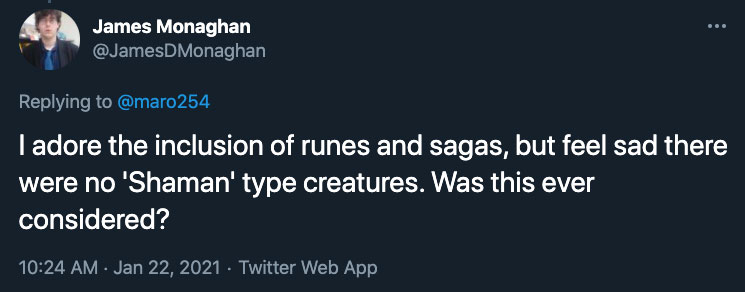
It's possible we had some Shaman at some point. I assume it fell victim to the need to support Cleric and Wizard for the party mechanic from Zendikar Rising. In general, sets that have mechanical tribal weight, either from their own themes or those of sets around them, tend to have trouble creating as much creature type variety as sets that don't have any of those issues.
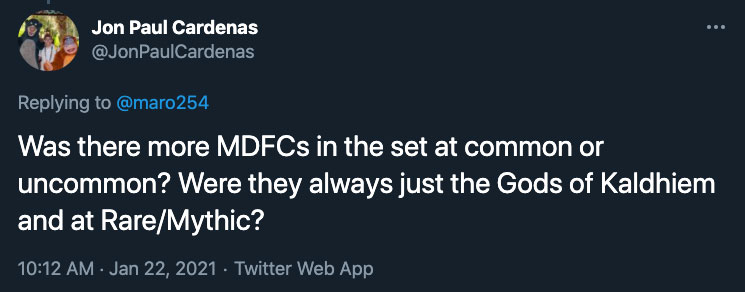
When I originally sketched out MDFCs in Kaldheim (before vision design even started), I tagged them as having a creature on the front side and another nonland permanent on the back. We did a small amount of design in the advanced design team (Aaron had me put together a mini design team to create some cards to help him sell the idea of a year of MDFCs to upper management) to show the type of cards Kaldheim might make, so we did explore the space a little. However, the idea to do the Gods as MDFCs happened so early in vision design that we never really explored any other implementations. I do believe there was one God at uncommon during vision design at one point, but it got removed before we handed over the file for set design.
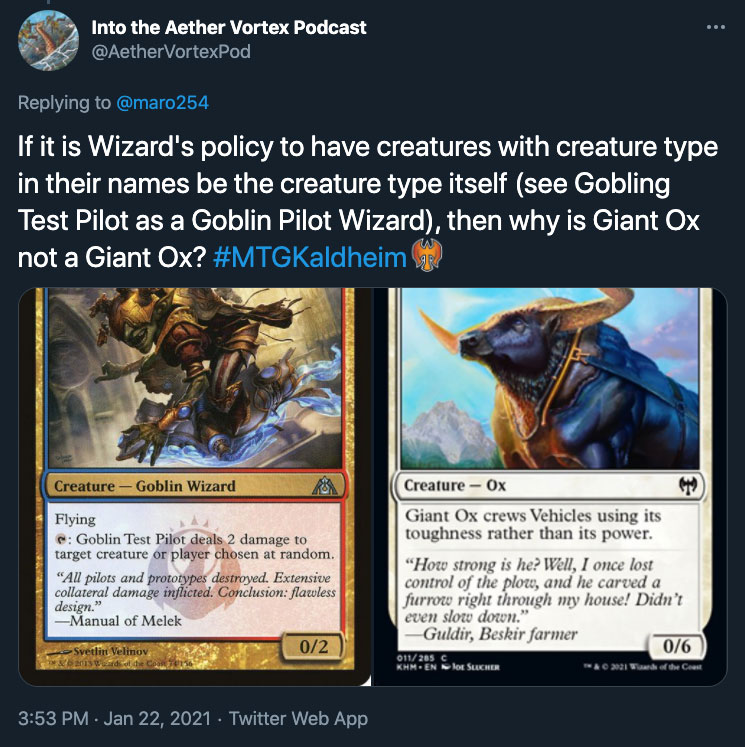
The word "giant" has two different meanings. As a noun, it's a type of fantasy creature, and as an adjective, it means large. Obviously, the two definitions are connected in their root as they both convey bigness. The creature type Giant is referring to the noun. The "Giant" in Giant Ox's name is the adjective. It's a very large ox. Being big doesn't make it creature type Giant. It's only a Giant if it's of the fantasy race giant. The rule about the creature type matching the name only applies if the word in the name is specifically referencing a race or class. That's why, for example, Giant Spider is also not a Giant.
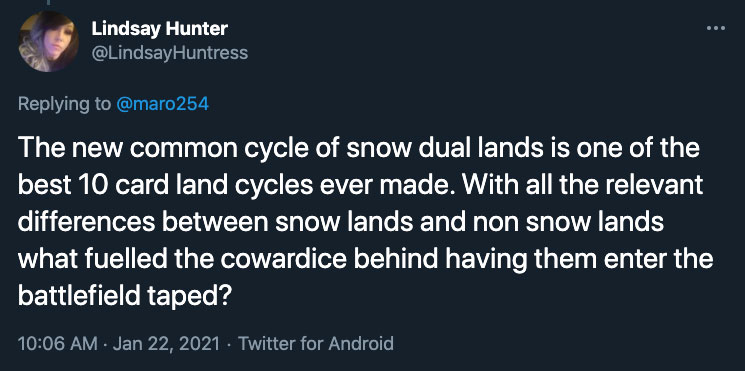
I wouldn't call caring about power level cowardice. If the snow duals entered the battlefield untapped, they'd be as good (and some might argue better) than the Alpha dual lands. R&D considers the Alpha dual lands too powerful. They make it easier than we want to access other colors. You can tell that from every other dual land we've ever printed.
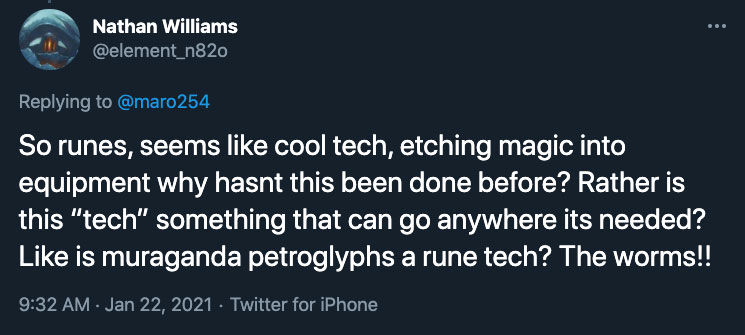
One of the cool things that can happen in design is that you get a new problem to solve and that problem leads you to a design that you hadn't thought of before. For example, Runes wanted to enchant Equipment, but it ended up being too narrow of a use case to be playable. The solution was to make an Aura that can double as a creature Aura to make it useful enough to see play (in Limited and casual Constructed; we'll have to see about tournament Constructed). However, now that we have this technology, we can apply it to future things.
Why hadn't we done it before? Flavorfully, we have. This isn't the first creative use of runes, it's just the first time we made a subtype to support it. We have mechanically tried to do something similar in the past, but we never found an answer we were happy with. I think the thing that helped push us in this case was how much runes showed up in the Norse source material. This time when we designed something in this flavor space that didn't work, we didn't quit, we kept trying other things.
So, will we see the Rune tech again? I think we might, but the more players like it, the better the chances of its return.
I've Been Through the Desert on a Norse with No Name
That's all the time I have for today. Thanks to everyone who sent in questions. As always, I'm eager to hear your feedback. You can email me or contact me through any of my social media accounts (Twitter, Tumblr, Instagram, and TikTok) to share your opinions on any of my answers or on Kaldheim.
Join me next week when I answer more questions from all of you.
Until then, may you keep asking questions.
#805: Olivia Gobert-Hicks
#805: Olivia Gobert-Hicks
32:33
In this podcast, I interview Olivia Gobert-Hicks to talk about Commander, cosplaying, and the Magic community.
#806: Angels, Part 1
#806: Angels, Part 1
31:37
In this podcast, I begin from Alpha and start talking about Angel cards and their design.
- Episode 804 Luis Scott-Vargas
- Episode 803 Kaldheim, Part 2
- Episode 802 Kaldheim, Part 1

